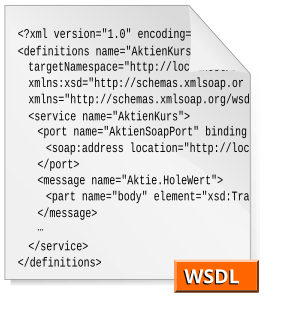Related Research Articles

The Hypertext Transfer Protocol (HTTP) is an application layer protocol in the Internet protocol suite model for distributed, collaborative, hypermedia information systems. HTTP is the foundation of data communication for the World Wide Web, where hypertext documents include hyperlinks to other resources that the user can easily access, for example by a mouse click or by tapping the screen in a web browser.
The Semantic Web, sometimes known as Web 3.0, is an extension of the World Wide Web through standards set by the World Wide Web Consortium (W3C). The goal of the Semantic Web is to make Internet data machine-readable.
A Uniform Resource Identifier (URI) is a unique sequence of characters that identifies a logical or physical resource used by web technologies. URIs may be used to identify anything, including real-world objects, such as people and places, concepts, or information resources such as web pages and books. Some URIs provide a means of locating and retrieving information resources on a network ; these are Uniform Resource Locators (URLs). A URL provides the location of the resource. A URI identifies the resource by name at the specified location or URL. Other URIs provide only a unique name, without a means of locating or retrieving the resource or information about it, these are Uniform Resource Names (URNs). The web technologies that use URIs are not limited to web browsers. URIs are used to identify anything described using the Resource Description Framework (RDF), for example, concepts that are part of an ontology defined using the Web Ontology Language (OWL), and people who are described using the Friend of a Friend vocabulary would each have an individual URI.
The Resource Description Framework (RDF) is a World Wide Web Consortium (W3C) standard originally designed as a data model for metadata. It has come to be used as a general method for description and exchange of graph data. RDF provides a variety of syntax notations and data serialization formats with Turtle currently being the most widely used notation.
The World Wide Web Consortium (W3C)'s Web Accessibility Initiative (WAI) is an effort to improve the accessibility of the World Wide Web for people with disabilities. People with disabilities may encounter difficulties when using computers generally, but also on the Web. Since people with disabilities often require non-standard devices and browsers, making websites more accessible also benefits a wide range of user agents and devices, including mobile devices, which have limited resources.
Web annotation refers to
- online annotations of web resources such as web pages or parts of them, and
- a set of W3C standards developed for this purpose.
The name Atom applies to a pair of related Web standards. The Atom Syndication Format is an XML language used for web feeds, while the Atom Publishing Protocol is a simple HTTP-based protocol for creating and updating web resources.
The Platform for Internet Content Selection (PICS) was a specification created by W3C that used metadata to label webpages to help parents and teachers control what children and students could access on the Internet. The W3C Protocol for Web Description Resources project integrates PICS concepts with RDF. PICS was superseded by POWDER, which itself is no longer actively developed. PICS often used a content labeling from the Internet Content Rating Association, which has also been discontinued by the Family Online Safety Institute's board of directors. An alternative self-rating system, named Voluntary Content Rating, was devised by Solid Oak Software in 2010, in response to the perceived complexity of PICS.
Web standards are the formal, non-proprietary standards and other technical specifications that define and describe aspects of the World Wide Web. In recent years, the term has been more frequently associated with the trend of endorsing a set of standardized best practices for building web sites, and a philosophy of web design and development that includes those methods.
Representational state transfer (REST) is a software architectural style that was created to guide the design and development of the architecture for the World Wide Web. REST defines a set of constraints for how the architecture of an Internet-scale distributed hypermedia system, such as the Web, should behave. The REST architectural style emphasises the scalability of interactions between components, uniform interfaces, independent deployment of components, and the creation of a layered architecture to facilitate caching components to reduce user-perceived latency, enforce security, and encapsulate legacy systems.
A powder is a collection of very fine particles that may flow freely when shaken or tilted.
RDF Schema is a set of classes with certain properties using the RDF extensible knowledge representation data model, providing basic elements for the description of ontologies. It uses various forms of RDF vocabularies, intended to structure RDF resources. RDF and RDFS can be saved in a triplestore, then one can extract some knowledge from them using a query language, like SPARQL.
Web syndication technologies were preceded by metadata standards such as the Meta Content Framework (MCF) and the Resource Description Framework (RDF), as well as by 'push' specifications such as Channel Definition Format (CDF). Early web syndication standards included Information and Content Exchange (ICE) and RSS. More recent specifications include Atom and GData.
The W3C Device Description Working Group (DDWG), operating as part of the World Wide Web Consortium (W3C) Mobile Web Initiative (MWI), was chartered to "foster the provision and access to device descriptions that can be used in support of Web-enabled applications that provide an appropriate user experience on mobile devices." Mobile devices exhibit the greatest diversity of capabilities, and therefore present the greatest challenge to content adaptation technologies. The group published several documents, including a list of requirements for an interface to a Device Description Repository (DDR) and a standard interface meeting those requirements.
An Emotion Markup Language has first been defined by the W3C Emotion Incubator Group (EmoXG) as a general-purpose emotion annotation and representation language, which should be usable in a large variety of technological contexts where emotions need to be represented. Emotion-oriented computing is gaining importance as interactive technological systems become more sophisticated. Representing the emotional states of a user or the emotional states to be simulated by a user interface requires a suitable representation format; in this case a markup language is used.
A Biositemap is a way for a biomedical research institution of organisation to show how biological information is distributed throughout their Information Technology systems and networks. This information may be shared with other organisations and researchers.
The Semantic Sensor Web (SSW) is a marriage of sensor and Semantic Web technologies. The encoding of sensor descriptions and sensor observation data with Semantic Web languages enables more expressive representation, advanced access, and formal analysis of sensor resources. The SSW annotates sensor data with spatial, temporal, and thematic semantic metadata. This technique builds on current standardization efforts within the Open Geospatial Consortium's Sensor Web Enablement (SWE) and extends them with Semantic Web technologies to provide enhanced descriptions and access to sensor data.

The Web Services Description Language is an XML-based interface description language that is used for describing the functionality offered by a web service. The acronym is also used for any specific WSDL description of a web service, which provides a machine-readable description of how the service can be called, what parameters it expects, and what data structures it returns. Therefore, its purpose is roughly similar to that of a type signature in a programming language.

OStatus is an open standard for federated microblogging, allowing users on one website to send and receive status updates with users on another website. The standard describes how a suite of open protocols, including Atom, Activity Streams, WebSub, Salmon, and WebFinger, can be used together, which enables different microblogging server implementations to route status updates between their users back-and-forth, in near real-time.

Apache Marmotta is a linked data platform that comprises several components. In its most basic configuration it is a Linked Data server. Marmotta is one of the reference projects early implementing the new Linked Data Platform recommendation that is being developed by W3C.